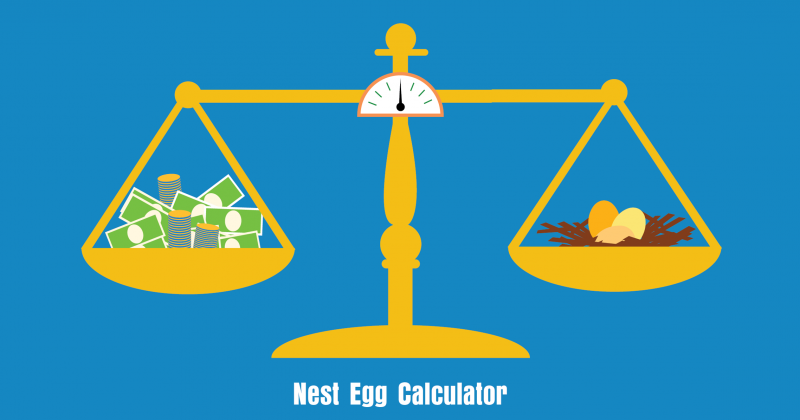There are two primary groups of calculators. One group is devoted to various cash nest egg and “annuity” considerations. Another group concerns (A) the best way to get into a mortgage, and (B) the best way to get out of one that takes you past age 50-55.
Note: These calculators are used with the understanding that they do not constitute financial, legal, accounting, or professional advice. Although the data should prove useful, neither we or any party assumes liability for the accuracy, merchantability, or fitness of this data. All warranties, expressed or implied, are excluded.

Nest Egg and Monthly Withdrawals
“Pound of Crop is worth a ton of theory.” The theory is 15 years of former mortgage payments are worth five times annual income, precisely the amount you should have in the bank at retirement. Such a nest egg will provide half of your living expenses. With Social Security and other income such as 401(k) plans providing the other half, Millennials can retire with peace of mind.
It’s important that Millennials can prove it to themselves. And, also to see the importance of compound earnings. It’s simple to multiply the amount of monthly deposits against the number of months, but a calculator is needed to factor in the annual earnings rate, which compounds on itself over time.
Compound earnings come in two waves. The first during the years when the nest egg is being built. The second wave during the decades of monthly withdrawals. Because the balance is earning income at same time that withdrawals are reducing it, the nest egg can last for 20 years. All together, by the time the fund is depleted, half of the withdrawals will have come from compound earnings. In other words, a comfortable retirement depends on compound earnings; getting the time-value of money on your side.
* Data cannot be saved by you or the system. All values return to zero when calculator is closed.
Evaluating a Prospective Mortgage
The key is to understand what you gain and what you lose for taking a long term mortgage, 30-years, over a shorter term one, 15 years for instance. Only then can you evaluate whether the tradeoff is worth it.
It’s a two-step process. First step is to calculate the Gain in Borrowing Power for a mortgage that will take you 5, 10, or 15 years beyond age 50-55. The Borrowing Power calculator will compute this increase.
Second step is to calculate the Loss of Monthly Withdrawals over 20 years, the opportunity loss.
Understanding this loss helps a homeowner make a smart informed decision when buying a house. Comparing two properties for example, one with an extra improvement or amenities and one without. Naturally, everyone wants the “extras,” but at what cost? Is an updated kitchen worth five years of extra payments, which translates into smaller monthly withdrawals during retirement, for instance?
Pinpointing the Gain in Borrowing Power can also help you “buy back time.” In the event you had no choice but to start with a longer term mortgage, targeting the Gain will recapture more time at less money than repaying a haphazard amount.
Even if you don’t act on these insights now, they’ll help you become a more informed buyer. Once so enlightened, these insights might play an important role later on.
* Data cannot be saved by you or the system. All values return to zero when calculator is closed.
Buying Back “Time”
The concept is simple and straightforward: Homeowners borrowed extra money by promising to make monthly payments for a longer period, e.g. five to fifteen years longer. You can buy back many of those extra payments by simply giving back the extra money. (Repayment schedule is just the minimum, free to pay more.) In a nutshell, you’re simply buying back the time you traded away earlier. Presto!
There’s a technical way to budget the repayment. And there’s Cowboy Math. Whatever the method, pinpointing the Gain in Borrowing Power will act as guide rails. The technical approach calls for a methodical plan to repay the Gain over five years. Cowboy Math repays it according money available at the time.
First, you must calculate the gain in borrowing power with the Borrowing Power calculator. Establish a 15-year term as the base period. Input the data for 20 or 30-years terms. The difference is the Gain in Borrowing Power. That’s the amount that must be repaid ahead of schedule in order to recapture 5, 10, or 15 years of payments.
The technical method calls a budget that will repay it over five years. (See “Unscramble Your Nest Egg,” 1990 and 1994.) This will recapture more time with less money because the preponderance of interest is stacked in the front of the schedule (no, the lender didn’t stack it there but that’s another story). You can do almost as good without fancy formulas, however.
The Cowboy Math repays the increase in borrowing power according to practical considerations and limitations. Some will make monthly payments. Other people will make once a year lump-sum payments. Still others will do both. Many will do it whenever they have extra money. A few will even print out the amortization schedule, and accelerate repayment according to the amount of principal in the next X number of payments. That way, they can track their progress. Whatever the method, all paths lead to the mountaintop.
How you get there is secondary. All that matters is recapturing the time and payments for a nest egg of your own!
Amortization Schedule
Once upon a time, all borrowers were given a schedule that showed the month by month allocation of the monthly payment to principal reduction and interest expense. That way, borrowers could see where they stood at any time.
Lenders seldom provide Amortization Schedules any longer. Easy enough to get one from the internet, however. Just input a few pieces of information, and you can print it out.
It could also be used to plot an accelerated pay-off schedule. Homeowners could add the next three principal payments, for example, and add that amount to their normal monthly payment. Side benefit in keeping to the original payoff schedule is ability to double check the principal prepayment was applied correctly. (Misinformed clerks have sometimes applied it to “prepaid interest.” They fail to understand the schedule is just an assumption, not a requirement. Soon as interest is brought up to date, no more is due and thus can’t be “prepaid.”)


